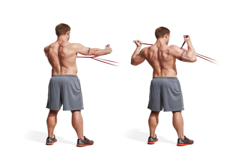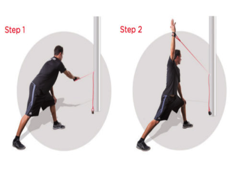|
What is “Little Leaguer’s Elbow”?
The term “Little Leaguer’s Elbow” refers to a stress response that happens to the inside part of the elbow from increased stress from throwing. The clinical term ‘medial apophysitis’ refers to the inflammation or swelling and irritation of the growth plate (apophysis) on the inside part of the elbow. The elbow gets irritated when young throwing athletes stress their arm repeatedly in the cocking phase (reaching back) of a throw. As an athlete reaches back to throw, there is a force on the inside of the elbow (valgus stress) which puts added strain on the growth plate and can cause inflammation. At the same time, there can be a compressive force that occurs on the outside of the elbow as well. This is different from a UCL (ulnar collateral ligament) injury that most baseball players associate with ‘Tommy John’ injuries, since no ligaments are torn in LL elbow. In general, younger pitchers tend to injure growth plates while older and more developmentally mature pitchers tend to be more likely to tear their ligaments requiring a UCL reconstruction (Tommy John surgery). General causes of elbow pain in youth baseball players include poor throwing mechanics (overusing the arm while underusing the lower body), lack of proper time away from throwing (3-4 months is recommended), poor posture, and a lack of strength in the legs or trunk. While there are not specific exercises to avoid LL elbow, addressing the above risk factors are the key to preventing elbow injuries. If a player complains of pain on the inside of the elbow while throwing, they should be taken out and allowed to rest until the pain is no longer present with throwing. A simple and effective test to do is called the milking valgus stress test pictured below. When pulling the hand out to the side, pain in the inside part of the elbow indicates inflamed and irritated tissues and a player should not throw through this pain. If a player continues to throw through elbow pain, there is a much higher risk of sustaining more serious arm injuries. For questions or comments or to submit requests for other topics, please email seth.blee@inova.org
0 Comments
Oblique muscle strains are one of the most common baseball injuries that do not involve the shoulder or elbow. They are also common to other sports that involve a high demand on trunk rotational control (golf, hockey, wrestling). These strains involve the deep fibers of the muscles of the trunk or torso that have to control the transfer of energy from the lower body to the upper body with both swinging and throwing. The trunk is the transition between the lower and upper halves of the body and it needs to maintain stability to allow for effective energy transfer between the two parts. The trunk muscles also have to control the rotation of the midsection that is so important particularly for hitting. The most common muscles involved are the internal and external obliques which are referred to as the deep abdominal muscles. They provide a much more important role in stabilization than the more superficial rectus abdominus muscles, which many people refer to as the six pack muscles.
Because baseball (and other rotational sports) typically involves a forceful and repetitive trunk twisting motion, these muscles are particularly susceptible to strains when overused or when not trained properly. There are a few key exercises to incorporate to ensure stability of these muscles to both train for rotation and also to resist rotation forces. When training to improve rotational control, exercises like ball throws or band rotations are key. These exercises should always go to both directions and a player should train at least as much to their non-hitting side as to their hitting side so that they are always training in both directions. Exercises to avoid rotation (counter-rotation movements) are also critical to help with stability. Common exercises for these movements include planks and pallof presses pictured below. For questions, feedback, or topic requests, please email SportsPT@inova.org.  For this edition of the injury prevention blog, I wanted to address one of the most common questions that I hear when I speak with coaches, players, and parents. I am often asked: “What do you think about weighted ball throwing programs?” “Will throwing a weighted ball help to increase throwing velocity?” This is a topic that has been debated by physical therapists, athletic trainers, strength trainers, and pitching coaches for years. There have been several research articles written about the topic, the most recent of which, the “Effect of a 6-week weighted baseball throwing program on pitch velocity, pitching arm biomechanics, passive range of motion, and injury rates”, written by Mike Reinold, PT, DPT and Dr James Andrews sheds some interesting light on the subject. Since all players are desperately trying to throw harder, there are many programs, web sites, and theories out there that have tried to find the secret. One such theory is that throwing a heavier ball will strengthen the arm and then allow the player to throw a standard weight baseball even harder. The research on this has been mixed at best. This recent study cited above compared 2 groups of teenager baseball players that threw weighted balls in addition to strengthening and routine baseball activities with another that threw only standard weight baseballs. The key results were that the weighted ball group had:
So how does a player throw harder? The answer is to learn to better use the entire body. The legs produce the force, the trunk transfers the force, and the arm just delivers the ball. Therefore, the stronger the lower half and the more stable the trunk and core, the harder that a player will throw. There is no secret weapon out there that substitutes for a stronger kinetic chain and proper throwing mechanics. In addition, some of the tools that players use may actually lead to an increased risk of injury. For questions or comments or to submit requests for other topics, please email SportsPT@inova.org 
So, what should be done to prevent a SLAP tear? There are many factors that contribute to tears of throwing shoulders including taking ample time off, having efficient mechanics and good use of the lower body and core, etc. The most important muscles to keep strong and healthy are the posterior rotator cuff muscles. The stronger that the cuff is, the better that the ball of the shoulder (humeral head) will be held in the socket and the less likely that it will peel back the top of the labrum. Two important exercises to include are external rotations (“W”) and reverse throws. In both cases, the emphasis should be on slow control of the exercises, especially in the return to starting position (eccentric strengthening). “W” exercise: Holding a band at shoulder height, pull the bands back into external rotation without arching your back. Slowly return to the starting position. Reverse throws: starting in a lunge position, pull back into a wind-up position (can vary based on normal arm slot) and then slowly return to starting position. The return should be done in slow motion and should be about 1/3rd the speed of the pull back. |
Dr. Seth BleeSeth is the Senior Director for Inova Physical Therapy Centers with oversight of 20 outpatient clinics in Northern Virginia. He graduated from Boston College's pre-medical program with a BS in philosophy. He then went on to physical therapy school and graduated with honors from Columbia University in New York with a Master’s of Science in Physical Therapy in 1998. Since graduating, Seth has worked with several different patient populations, but has focused the majority of his time in orthopedics and Sports. Seth is also certified in Sportsmetrics for injury prevention, trigger point dry needling, and Blood Flow Restriction therapy. Seth is a Certified Strength and Conditioning Specialist, which he integrates into his treatment of athletes of all ages. In addition to his clinical hours and his teaching and residency hours, Seth joined the medical staff of the Washington Nationals as their Lead Team Physical Therapist in 2016. He has also treated professional football, basketball, hockey, lacrosse, and Inova Physical Therapy Center- Sports Medicine Clinic soccer players and became the Team Physical Therapist for the NWSL (National Women’s Soccer League) Washington Spirit in 2020 as well. He has done multiple podcasts discussing rehab in professional sports and has been on ESPN as part of the E60 Project 11 program.
ArchivesCategories
All
|














 RSS Feed
RSS Feed
